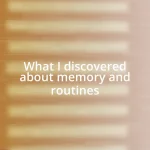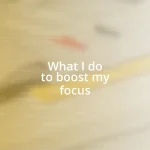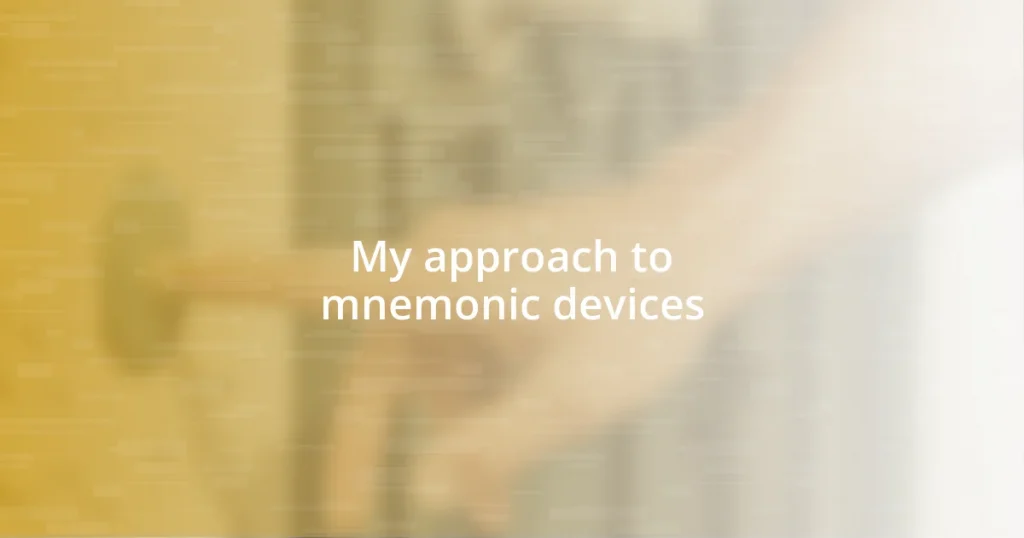Key takeaways:
- Mnemonic devices enhance memory retention by simplifying complex information through creative methods like acronyms, rhymes, and visual imagery.
- They promote active engagement and boost confidence, making learning enjoyable and encouraging deeper connections with the material.
- Effective mnemonics can be created by associating information with memorable structures, and regular practice reinforces recall through repetition.

Introduction to mnemonic devices
Mnemonic devices are powerful tools that help us remember information in a structured and fun way. I remember when I first discovered them during a history class—I struggled to memorize dates until my teacher introduced us to acronyms. Suddenly, a jumble of numbers became “My Very Educated Mother Just Served Us Noodles,” transforming frustration into a delightful game.
These techniques leverage the brain’s natural inclination for patterns and associations. Have you ever tried to remember something by linking it to a quirky image or a silly phrase? It’s fascinating how our minds can latch onto these connections, making recall not just easier but also more enjoyable.
For me, creating visual stories has always been the most effective method. I once needed to remember a complex list of ingredients for a recipe, so I crafted a ridiculous tale about a dancing onion and a singing carrot. That story stayed with me well beyond cooking that day! In essence, mnemonic devices reveal the playful side of learning, and they can transform tedious memorization into a creative adventure.

Benefits of using mnemonic devices
Mnemonic devices offer several benefits that can significantly enhance our memory and learning experiences. First and foremost, they simplify complex information into manageable chunks. For example, I remember struggling to memorize the order of the planets in our solar system. Using the mnemonic “My Very Educated Mother Just Served Us Nachos” not only made it easy to recall the planets but also added a touch of humor to my studying. The joy of creativity encourages a deeper connection with the material!
Moreover, these devices promote active engagement. When crafting a mnemonic, you’re not just passively receiving information; you’re actively participating in its creation. I fondly recall how, during a biology class, my friends and I created a catchy tune for the phases of mitosis. Singing that little ditty made it so much easier to remember, and it fostered a sense of camaraderie among us. Learning became a fun team sport!
Lastly, mnemonic devices boost confidence. When I started using them, I noticed improvements in my recall abilities, which in turn empowered me to tackle more challenging subjects with enthusiasm. The more successful experiences I had with them, the more motivated I became to delve into new topics. Have you ever felt that rush of excitement after effortlessly recalling information because you used a mnemonic? It’s a game changer!
| Benefits | Examples |
|---|---|
| Simplifies Information | Using acronyms to remember lists, like planets |
| Promotes Engagement | Creating tunes with friends for studying |
| Boosts Confidence | Improved recall leads to tackling harder subjects |

Types of mnemonic devices
Mnemonic devices come in various forms, each suited for different types of information. My go-to has always been acronyms—shortened phrases that help me remember longer concepts. One time, I was faced with a daunting list of historical events for an exam, so I created “FIVE PEEPS” to remember key figures. It helped me feel a bit like a detective, piecing together a story with vivid characters.
Here are some common types of mnemonic devices you can explore:
- Acronyms: Forming a word using the first letters of a list (like “FIVE PEEPS”).
- Rhymes and Songs: Using melodies or catchy phrases; once, I set a math formula to a jingle, and I’ve never forgotten it since!
- Visual Imagery: Creating mental images to represent concepts (like picturing a giant apple for “A” in an exam question about agriculture).
- Chunking: Breaking down larger pieces of info into smaller, manageable units, which helped me memorize phone numbers easily.
- Method of Loci: Associating items with specific physical locations in a familiar place; I remember using this technique for a final presentation once, walking through my childhood home in my mind!
Each type has its own charm and effectiveness, depending on what feels right for you. I encourage you to experiment and find the methods that resonate most with your own learning style!

Steps to create effective mnemonics
To create effective mnemonics, start by identifying the information you need to memorize. I often write down key terms on a sticky note and then brainstorm ways to connect them. For instance, when I was learning a new language, I used a playful association technique by linking unfamiliar vocabulary with funny images or situations. Can you think of a word that reminds you of a quirky memory?
Next, consider the structure of your mnemonic. Make it memorable by incorporating rhythm or humor. Once, while preparing for a history quiz, I turned a list of dates into a silly song. The absurdity of the lyrics helped solidify the dates in my mind—who knew a bit of silliness could pack such a powerful punch? Seriously, why not let your creativity run wild?
Lastly, practice recalling your mnemonic regularly to reinforce your memory. I like to quiz myself during short breaks or while commuting. Repetition is key! One time, during a road trip, I recited the mnemonic for a presentation until it became second nature. It’s amazing how consistency transforms a simple phrase into a lasting mental image. How often do you find yourself revisiting what you’ve learned? Repetition may just be your best ally in the pursuit of lasting memory!

Examples of effective mnemonic devices
When I think about visual imagery as a mnemonic device, I remember how it helped me tackle a complex biology concept. For instance, I vividly imagined a colorful explosion of fireworks representing the stages of cellular respiration. Each burst helped me recall the specific processes like glycolysis and the Krebs cycle. Doesn’t it feel amazing when a bright image locks information into your memory?
Rhymes and songs can be particularly powerful too. I recall once trying to memorize the order of the planets and creating a little tune. Singing “My Very Educated Mother Just Served Us Noodles” not only made me chuckle but also ensured I didn’t mix up Neptune and Uranus. Have you ever noticed how a catchy jingle sticks, often more than just plain facts?
Chunking is another technique I find invaluable. When I needed to memorize my family’s new phone numbers, I broke them down into smaller groups. Instead of struggling with the entire sequence, I’d recall “555-0123” as “555” and “0123.” It felt more manageable, like tackling a puzzle one piece at a time. Have you noticed how organizing information makes it less daunting? Each chunk felt like a little victory in my quest for memory mastery!















